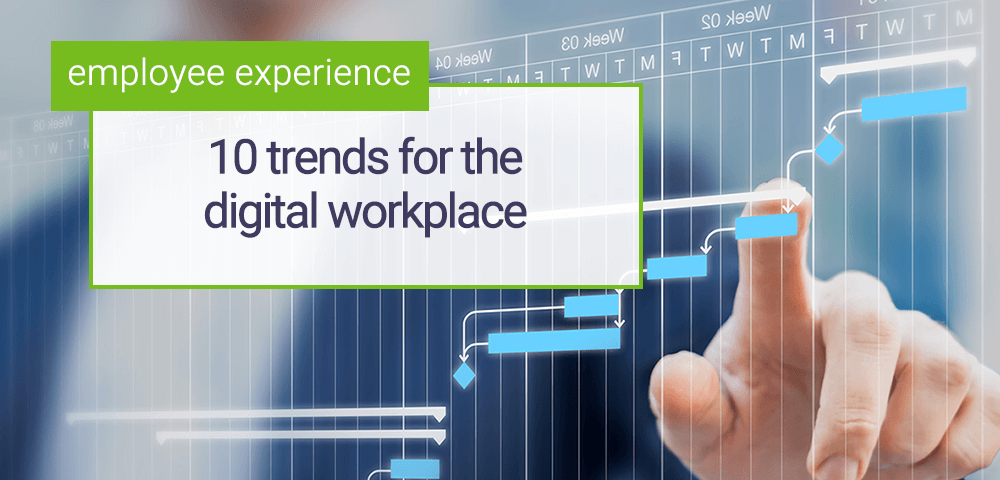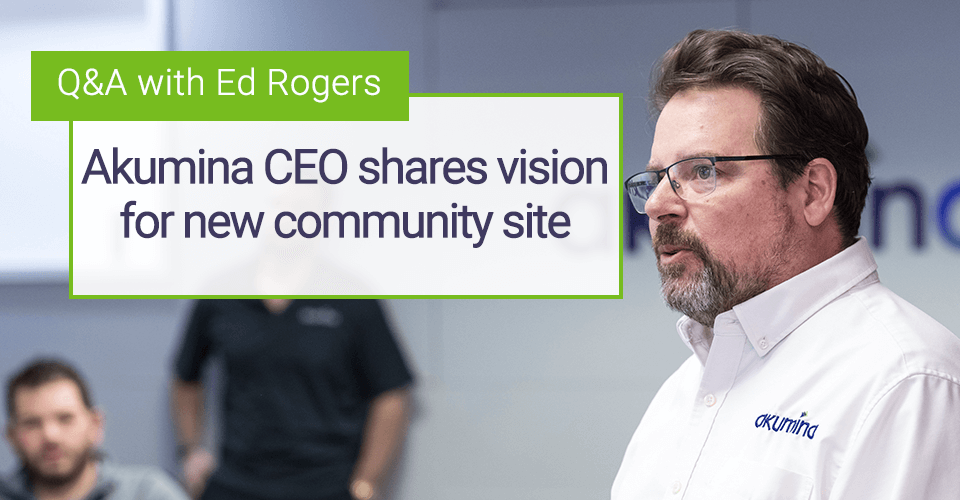10 trends for the digital workplace

Employee experience platforms must adapt to how we work
It’s time to bring some DXP to EXP.
What if you could bring all the functionality of digital experience platforms for consumers and businesses to an employee experience platform for your most valuable commodity – your team?
Think about it.
If you can feed your dog from your cellphone, play music and make calls from your car’s steering wheel, or skip the line at Disney World with a chip in a magic band bracelet, why does your digital workplace still feel so analog?
What if the internet of things (IoT) came to your company’s modern intranet? What if you were treated like a consumer – at work?
Here are 10 trends that show the necessity of engaging employee experiences and where the digital workplace is heading:
1. Always-on culture: It’s not just your friends or social media distracting you during your personal time – it’s your coworkers, your boss, or impending deadlines. You don’t shut off, your devices don’t shut off, and sometimes work doesn’t shut off. Chances are, your phone, your tablet, or your laptop are with you at all times. Easy access to communication, software, documents, and project management tools has to be with you from any virtual desktop infrastructure (VDI).
2. Virtual teams and cloud-based collaboration: It’s not just people who work remotely, it’s teams of employees spread across different time zones for big global businesses, said Steve Bynghall, a consultant, researcher, and writer who specializes in the digital workplace and intranets.
“Even if they’re working in offices, they still have remote and virtual working because they are working with people who aren’t there,” Bynghall said.
3. Deskless workers: Not only do many workers not collaborate from the same office, or at the same times, so many employees don’t even work behind a computer or at a desk. Workers in construction or manufacturing, for instance, still need access to a digital workplace, communication, and all of the same resources that companies can provide.
“Today 80 percent of the global workforce are ‘deskless’ – i.e. do their jobs away from a desk or computer screen – yet only 1 percent of the $300 billion in software venture capital each year is spend on technology for this group,” according to CMS wire.
4. Artificial intelligence (AI) and personalization: Conversational user interfaces using artificial intelligence aren’t just for B2C or B2B, they could improve your employee experiences. The possibilities for human resources or IT to provide help, information, content, and reminders through chat could improve efficiency and communication from onboarding through the entire employee lifecycle. Hyper-personalization, data collection and analysis, and machine learning will also provide tools to anticipate employee needs.
“People are expecting to have far more personalized experiences, which obviously, platforms like Akumina help, and (Microsoft) Office 365, in terms of content and the tools they access,” Bynghall said.
5. Better search and voice-enabled search: It is an absolute must for employees to find what they’re looking for across systems. Good search, as elusive as it can be, is just the first step. But as voice-enabled search or voice-recognition technologies become a bigger part of our personal lives (Siri, Alexa, Google Home, texting, etc.), our interactive digital workplaces need employee experience platforms that can keep up.
6. Data privacy: Just like any other data collected in the cloud, employees’ personal information needs to be protected across several systems, including a company’s modern intranet. Bank account numbers, medical information, social security numbers, tax information, addresses, family members, work histories and evaluations, conversations over messaging, personal credit card numbers used for expenses, third-party background checks, you name it.
Companies collect a ton of data on employees. Having an employee experience platform that doesn’t collect the data but sits on top of already-secure and approved systems is a distinct advantage.
7. Shadow IT and consumerization of IT: Increasingly, different departments within a company want to use outside systems and even non-approved applications as new technology becomes available to make their jobs easier. With thousands of software as a service (SaaS) products available to sales and marketing departments, for example, employees’ desire to use shiny, new things can lead to rogue systems and a (purposeful?) lack of communication with IT. Standardization and integration with your digital workplace become paramount if you want everything to work everywhere for everyone.
“An individual, or a team, or a division can completely bypass the IT department and introduce their own application or even build their own application and there’s very little governance over that, so it comes with its risks,” Bynghall said. “It also comes with some of its advantages, as well, in you can be far more innovative.”
8. Turnover and labor mobility: Keeping good employees is harder now. And not just millennials. Take a close look at your connections on LinkedIn – every generation is moving around … a lot. Sometimes it’s people starting second careers because of technological disruption. Sometimes it’s highly skilled workers thinking the grass is greener. Either way, workers expect more, and not just good benefits and work-life balance. They expect to be able to do their jobs well in collaborative and engaging workplaces. They expect hard work to pay off. The ability to work together, learn, grow, and adapt in an age when automation and younger, more tech-savvy employees (or outsourcing) might replace them has never been more important. Workplace culture has never been more important.
“There’s definitely an attitude that reminds me of freelancers, and they’re kind of prepared to jump ship, and don’t expect a job for life,” Bynghall said. “I think there is definitely a different user expectation that is driven by younger people who expect more and are open to new tools. It’s a more kind of fluid workforce.”
9. Gig economy: Flexibility and a fluid workforce go both ways. The benefit for smaller companies is being able to use well-qualified contractors or expert freelancers for project work to that the full-time staff doesn’t always have the head count or expertise for. Plus, some larger companies can try to leverage some of the advantages of a culture similar to a startup, Bynghall said.
10. Collaboration: Workers and enterprises are becoming more agile, more innovative, and building more meaningful relationships from better collaboration and teamwork. Bynghall points to a movement called “Working Out Loud” that centers around sharing work, creating a listening culture, and being open and transparent.
Coined by John Stepper, formerly of Deutsche Bank, the “Working Out Loud” idea is to build trust through experimenting and learning along the way within a small circle of peers as a support group. Come up with an idea, work with others, gather feedback, connect with others who can help accomplish a task, and empower yourselves as workers and your company as a whole to meet all of your stretch goals.
There are certainly other ways digital workplaces and digital workforces are going to evolve – smarter buildings, diversity and inclusion, and more. It’s important to recognize the trends, adapt, and build your teams and tech stacks, accordingly.
Your employee experience platform must be part of that equation.



